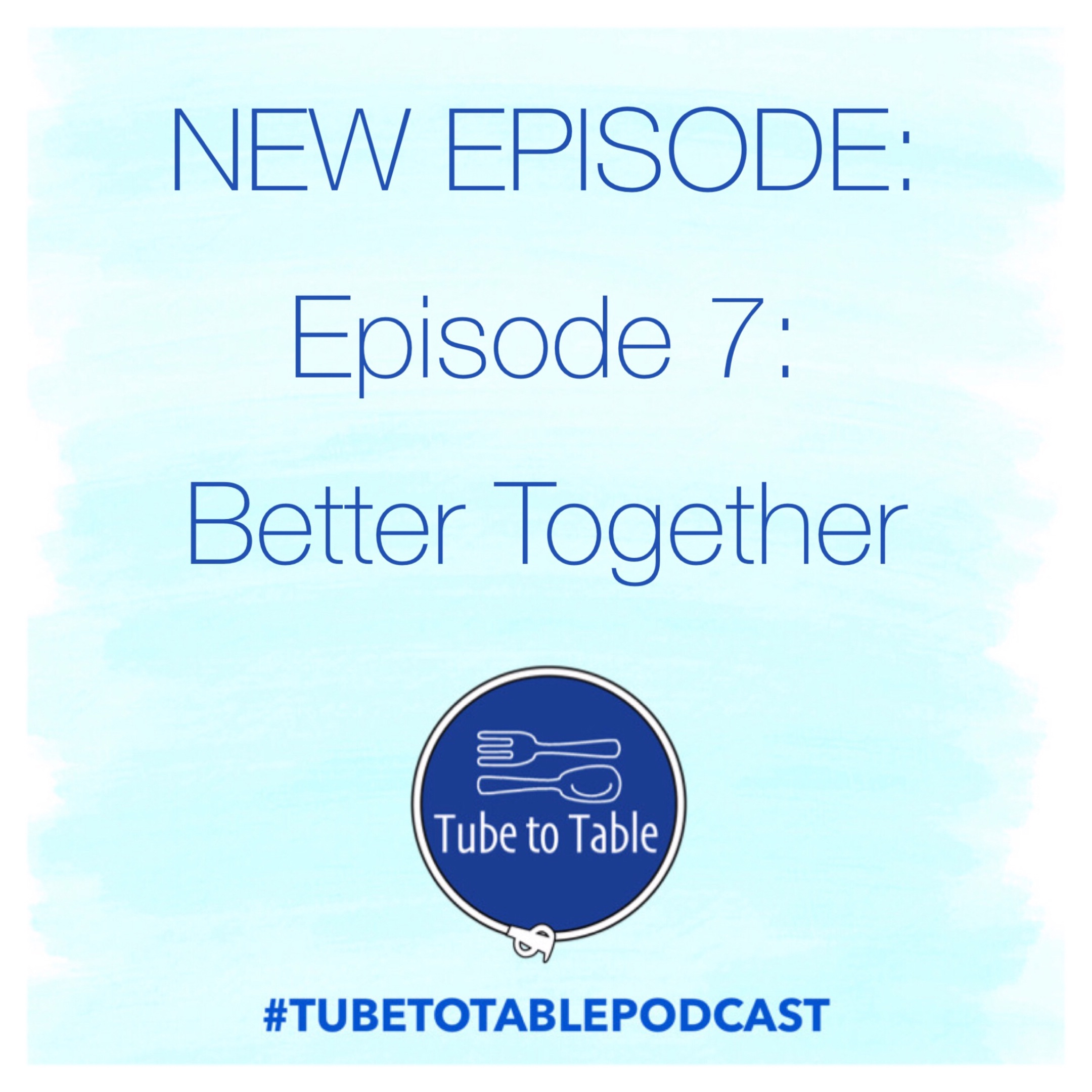Tube to Table Podcast Episode 7: Better Together
May 20, 2019
Posted in: Feeding, Feeding Tube Weaning, Tube To Table Podcast
What should a family mealtime look like? How can I create happy and healthy mealtimes for my child?
This week’s episode of Tube to Table discusses the principals behind building a positive and happy mealtime environment for your child. These mealtime foundations are relevant for children with a feeding tube, children with a feeding aversion, or families who are looking to improve their family mealtimes. Responsive mealtimes are mealtimes that encourage togetherness between family members, facilitate self-regulation, and are known to set the stage for a life-long healthy relationship with food. The family table is an important place to pay attention to and make improvements because it has been shown that what happens at the table sets the stage for eating habits later in life.
You can download this episode from Itunes, Stitcher, Spotify, Google Play, or listen to it below:
What is my role at the table?
As we have discussed in past episodes, it is important to establish the appropriate roles and responsibilities at your family mealtime. Ellyn Satter developed the Division of Responsibility (which describes the different roles of the parent and child at mealtimes.
- Parent’s Role: Choose the where, what, and when
- Child’s Role: Choose IF they are going to eat and HOW MUCH
This can become more complex as it is important to pay attention to what children are capable of and make sure that you are finding a balance by making sure they are safe, but also not “catering” to make sure they eat at a mealtime. When working to build your child’s relationship with food, you do not have to LOSE your role as a parent.
- As parents, you can continue to provide limits and boundaries at the table. The only thing you are NOT deciding is how much goes in their mouth and when
- Keep your child’s autonomy about what goes in their body and parents can keep their autonomy of having boundaries at the mealtime.
- Quality now leads to quantity later
To learn more about the division of responsibility and dive into the roles during mealtimes, check out our recent blog post here.
What do we talk about?
When a parent is concerned about what their child is eating, it is extremely hard not to talk about it all the time. We spoke last week about going out to dinner with friends and how it is not natural to talk about food all the time. Keep this in mind when you are having a mealtime with your family. Mealtimes can be hard, especially when you are thinking about what/how much your child is going to eat. It is OKAY to talk a little about the food (how it tastes, what it reminds you of), it is NOT OKAY to talk about what someone is choosing to eat or how much they are eating. The family table is a time where you are supposed to talk about your day, worries, excitements, and successes.
- We understand that not everyone is a great kid conversationalist. There are a lot of resources for conversation starters for children of any age. Pick a color of something you say during your day, take mental notes of something excited that happened at work.
- It’s okay if it’s not natural or you get stuck. There are resources to help you. If you need a longer list of resources check out last week’s episode’s show notes.
What does pressure look like?
It is important to allow your child to recognize what their body needs, even if it is not always “how much” you want them to eat. It is crucial to minimize pressure at mealtimes. What does this mean? It means to not use words that would encourage your child to take another bite, finish their plate, or open their mouth for food. The research shows that external pressure takes away the child’s ability to listen to their own body. By allowing your child to listen to their internal cues, you are protecting their relationship with food.
- Praise can be disguised as pressure. Praising during a mealtime can add unwanted pressure. This puts pressure on the child of “What if I can’t repeat it?” We often relate this to attempting to parallel park while everyone is watching you.
- This doesn’t mean you have to ignore their hard work, but there are other ways to encourage your child during a mealtime.
- Praise the effort more than you praise the results. The results may change, and you want your child to feel proud for participating in a mealtime no matter how much they eat.
- Praise your child as you would any other area in their life, and don’t let the praise at mealtimes exceed that. If it is proportional to the praise around other things, that is okay.
- With a lot of praise, food can be portrayed as a challenge because children recognize that we often praise things that are “hard work” or “new and challenging”.
What about “good” and “bad” foods?

The research shows us that when we use labels such as “good”, “bad”, “healthy”, we are interfering with a child’s ability to listen to what their body is telling them about food. Children should be able to get their energy needs met independently and it is important that if a certain food makes them feel a different way, they start to recognize those subtle differences in their body. If they are constantly hearing labels of what a food is “supposed” to be, then it gets in the way of them being independent.
- When children are just learning to eat, they typically do what feels safe to them. That might mean that they stick with one food for a little. That is OKAY. If they start to hear that the only thing they eat is “bad” then they may start to think, “Am I bad?”
- This can cause confusing and conflicting information for a child. For tube-fed kids specifically, there must be a foundation of quality and acceptance in order to move towards variety and increased intake.
- Responsive mealtimes mean accepting kids where they are and if something feels safe, letting them feel safe. Part of your job is to create a safe relationship and pathway for them to grow and develop.
What if I want my child to eat “healthy” foods?
As you start to make decisions about what your children eat, it is important to look at the research that shows forbidding foods often backfires and children need to be exposed to all different foods. Of course, this means with what is culturally expected in your family. You can still control what foods are in your house or what foods your family eats together.
- The research shows that children of all ages learn best while watching their parents. If you want your child to eat a variety of healthy foods, you should do that as well at the table.
- We often tell parents, “If we know they will want what you have, then you need to have what you want them to want”.
Labels extend beyond food, this also extends to your feelings about your body and the feelings you have about what you eat. Children can pick up on feelings of guilt or when they hear negative body language.
How much is enough?
When mealtimes are hard, an average or large portion size can feel scary and intimidating. Often, parents and therapists overestimate that portion size for a child. When children that have any type of selectivity or are tube-fed are given a large or average portion size, it can often feel like they have a huge mountain to climb.
- If you are plating food for your child with a feeding aversion, a picky eater, or a child who is tube-fed, keep portion size minimal with even a bite or two on the plate so there is some emptiness.
- This emptiness can help a child feel that they can try the food if they want to, but there is no pressure to “finish” their plate.
- Serving family style: This is tool that we often recommend because it encourages self-regulation, autonomy and trust around food, and it does not feel like something is being chosen for them.
When a child can choose the food they want, food becomes meaningful. When food is meaningful, it helps with their long-term relationship with food. For more information about portion sizes, check out our guest appearance on the Comfort Food Podcast a few weeks ago!
What should the focus be?
The focus of mealtimes should not be on the food, but on togetherness and the social opportunity to meet as a family. Mealtimes should feel mindful and not a hectic time. Of course, life happens, and it is okay if not every meal is perfect. Do not put too much pressure on yourself as a parent to have a “perfect” family mealtime every night. Your child is going to remember the positive association of togetherness about the meal, rather than what was served. It is okay if you are on the go, at a baseball game, running late, there is no such thing as a perfect mealtime. Remember the foundations that we discuss in this episode here and your child will have a memory of a positive, fun, and social mealtime with their family!
“A family mealtime should look like the family that is having it.” – Heidi Moreland

Be the first to comment